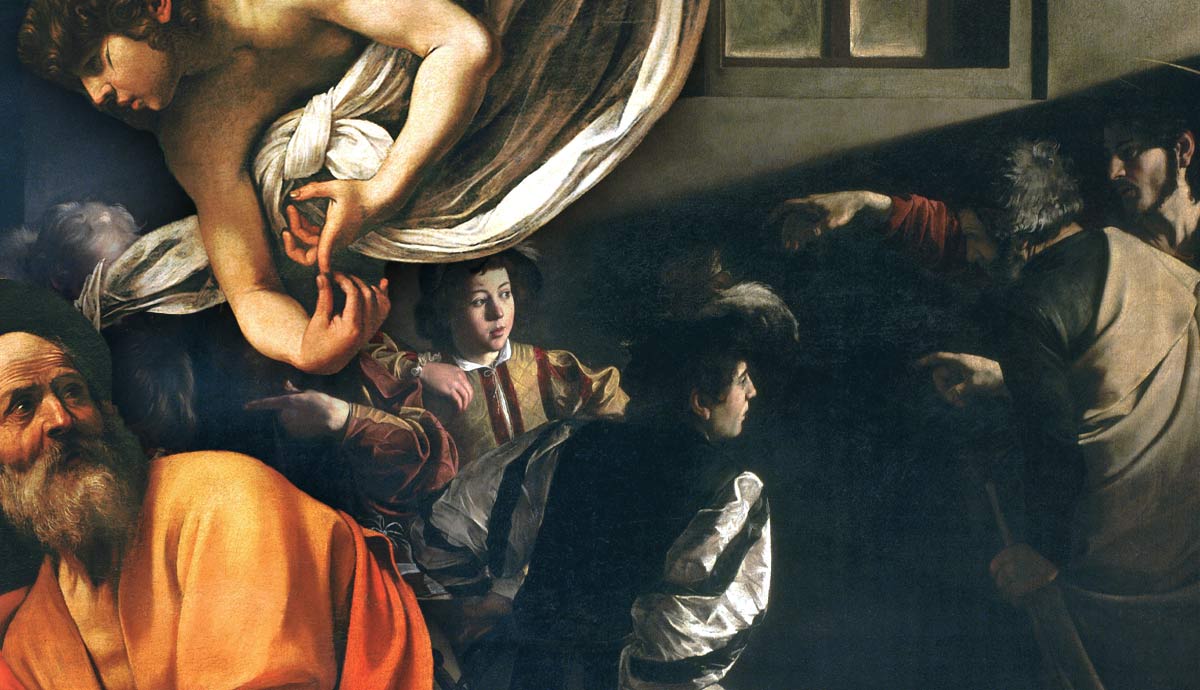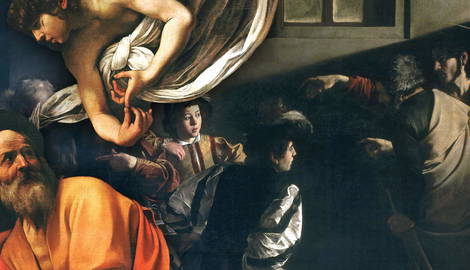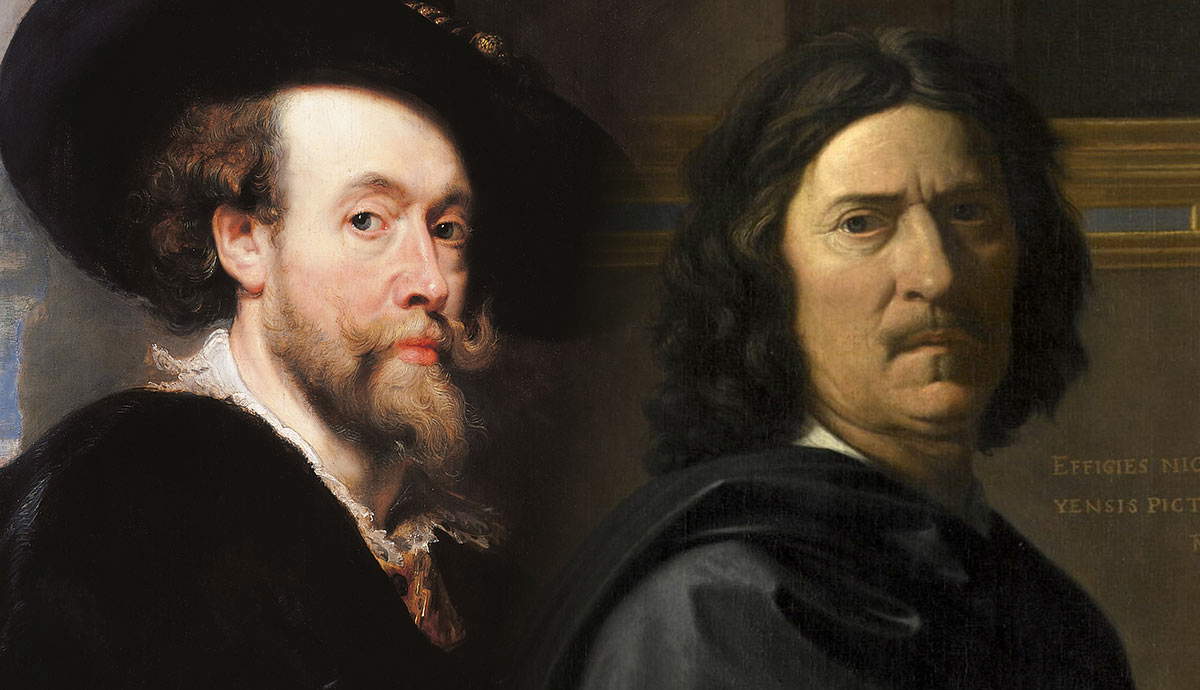
Caravaggio is one of the world’s most famous artists. To this day, his individualistic style is easily recognizable to many audiences. Scholars have spent countless decades studying his works, trying to unveil their deeper meanings. As an artist working in Rome, Caravaggio had very close ties to the Catholic Church. The 16th and 17th centuries were marked by a turbulent time for the Church, brought on by the revolutionary Martin Luther and his Protestant Reformation. Caravaggio stands as an exemplar of the Counter-Reformation, which is best seen in his Saint Matthew series.
Who was Caravaggio?

Michelangelo Merisi da Caravaggio (1571-1610) was born in Milan, but he traveled all throughout the Italian states during his time as an artist. Infamously marked by a lifetime of crime and revelry, the artist began his career as an apprentice under Milanese painter Simone Peterzano, a student of the Renaissance-era artist called Titian. He then left for Rome despite his extreme poverty and began to work under the Mannerist painter Giuseppe Cesari.

Many of Caravaggio’s early works represented genre scenes, including depictions of a Boy Peeling a Fruit and a Boy with a Basket of Fruit. His paintings quickly turned to moralistic works, such as one of his more famous scenes of the Fortune Teller. As his first work that depicted more than a singular figure, Fortune Teller fools the audience with a simple scene of a young man having his palm read by a Romani woman. Upon further inspection, the viewer can see that she is actually stealing his ring while his attention is diverted. Many of Caravaggio’s works from this period focused on the gritty inner workings of Roman street life—a place he was very familiar with since he participated in street brawls.

Church commissions dominated the Roman art scene, and Caravaggio was no exception. He caught the attention of Cardinal Francesco Maria del Monte with his painting of The Cardsharps. This friendship would prove largely beneficial to Caravaggio’s later scoring of large-scale patronage. His first religious work was the Penitent Magdalene, a painting that is noticeably lacking in overt Biblical themes. Here, the newly converted courtesan, Mary Magdalene, contemplates her life up until that moment. The drama is starkly removed from the work. Despite the peculiarity in which Caravaggio depicted the scene, his fame steadily continued to spread throughout Rome.

In 1599, Caravaggio was commissioned to decorate the Contarelli Chapel in the church of San Luigi dei Francesi. This contract produced his famous Saint Matthew series. This compilation of three artworks depicting important moments of the saint’s life skyrocketed the artist into further fame. The Calling, The Martyrdom, and The Inspiration, while commissioned for a private chapel, represent the goals of the church’s Counter-Reformation by representing dramatic scenes of conversion, sacrifice, and holy sainthood.
1. The Calling of Saint Matthew

The first image in Caravaggio’s Saint Matthew series comes from Matthew 9:9, whereupon Christ enters and points towards Matthew, beckoning him to follow. The tax collector sits at a table with four other men on the left side of the composition. Christ and Saint Peter stand on the right. Matthew is typically denoted as the man sitting in the middle, pointing to himself in a gesture that asks ‘Who, me?’ Those further away from Christ and Peter are unaware of their presence as they focus on the money gathered on the tabletop. The men to Matthew’s right notice the intruders. One sits with his arm on Matthew’s shoulder, while the other leans towards Christ and Peter.

This work shows a moment of conversion and spiritual awakening, a subject matter that was largely relevant in the Church’s Counter-Reformation efforts. Even without knowing the story that was unfolding, the audience can get a sense of awe. Matthew’s face shows surprise, with his eyes wide and eyebrows raised. The men who are aware of Christ mimic this facial expression, both of them with their mouths slightly parted. The figures at the table are in contemporaneous 16th-century dress, whereas Christ and Peter are denoted differently, wearing timeless robes. The division is emphasized by the physical separation of the groups. An empty space takes up the center of the composition, parting the mortal men from the holy Christ and Peter.

Surprisingly, Christ is not the central point of this story. In fact, he even seems to be lost in the darkness of the shadow—only the thin gold halo that sits above his head denotes his importance. Instead, Matthew is the focus, but even still, he does not sit in the middle of the composition. Importance and focus are brought through with light and gesture. The hallmark tenant of Caravaggio’s work is his use of tenebrism—a kind of spotlighting technique of intense chiaroscuro. The light source comes from the upper right of the canvas, pointing the viewer’s eye towards Matthew.

Christ’s hand creates a line towards the tax collector as well. His hand is not commanding, but instead, strangely limp. The inspiration for this gesture comes from Michelangelo’s Creation of Adam. This connection is important and deliberate. Parallels between Adam and Christ are a common iconographic symbol. Adam was the one who committed the original sin, whereas Christ is the savior of humanity. As the savior, Christ calls upon Matthew to follow him, turning him away from the sinful life of a tax collector.

In this composition, Caravaggio shows Matthew’s struggle between his profession and his awakening. He is seen using one hand to point inwards towards himself, as if shocked by Christ’s revelation, while his other hand is shown touching the money that’s resting upon the table. This dichotomy represents the inner battle of Matthew, capturing the moment of his conversion. This work is shockingly still, but the viewer can still get a sense of what will come afterward: Matthew will rise and follow Christ, beginning his new life as a saint. This act of spiritual awakening is meant to inspire the viewer, representing the power and glory of the Catholic Church.
2. The Martyrdom of Saint Matthew

Located opposite The Calling in the Contarelli Chapel, this scene of the death of Saint Matthew represents another important message of the Counter-Reformation—martyrdom. Here, the saint is sprawled out on the ground while his murderer stands viciously over him. Men are scattered around the scene, all shown in various stages of fright and surprise. An angel rises from the upper right, reaching out to Matthew.

Matthew’s hand is outstretched, a gesture that could be interpreted as either protection from the sword, or reaching up towards the palm that the angel is offering. Matthew’s death was called upon by the King of Ethiopia after the saint had rebuked the king for lusting after his niece, an abbess who was therefore off limits. The scene is invigorated with drama, again marked by Caravaggio’s tenebristic technique. Matthew and his killer are spotlit, intensely brighter than the rest of the scene, though the source of the light is less visible than in The Calling.

Despite being faced with death, Matthew is not afraid. Instead, he is calm and composed, knowing that his death is an act of martyrdom. Caravaggio represents this moment as one of joy and ecstasy for the saint—a convention that became largely popular in the Baroque era, such as with Bernini’s sculpture of Saint Teresa. The intense feelings associated with spiritualism were highlighted during the Counter-Reformation, invoking a sense of awe in viewers and emphasizing the beauty of conversion.

This work is still, like The Calling, but in a less contemplative sense. The composition captures a snapshot at the climax of the drama, as seen in the array of reactions to Matthew’s injury. The nude figures towards the front of the painting are converts awaiting baptism, once again stressing the importance of the act of conversion. Some cower in fear, crawling away from the action, as others watch in intense surprise. A figure, farthest in the back, watches on with a sorrowful expression—the figure actually represents a self-portrait of the artist. Still, Matthew is unafraid, accepting his fate as a martyr for his cause. This calm depiction of the saint once again strives to impress the audience, representing the glorious sacrifices he made for humanity.
3. The Inspiration of Saint Matthew

The final work in the series is The Inspiration of Saint Matthew. This canvas is the altarpiece, the center point of the cycle. While The Calling represents the first important part of Matthew’s story and The Martyrdom depicts the last, The Inspiration takes place in the middle. Here, the audience sees Matthew haphazardly sitting at a table, while an angel appears from the darkness above.

This work represents Matthew in one of his primary roles: the writer of the first gospel. The angel dictates to him, while the saint listens intently. There is a glaring lack of a setting. There is a table and chair that sits upon a floor, but there are no walls or discernible features of a room. The light source seems to be coming directly towards Matthew, as if emanating from the angel, or perhaps from the viewers themselves. Matthew is in such a hurry to receive the angel’s information that he does not even have the time to properly sit.

The angel’s wings are hardly noticeable, lost in the darkness of the background and mixed in with the white fabric draping. They are shockingly close to Matthew, who leans back, having his body create a dynamic S-curve. The saint is dressed in robes that mimic the ones that Christ and Peter wore in The Calling. Instead of the contemporaneous dress he wore in that composition, he is now adorned in cloth that represents that of an ancient Greek philosopher. This convention emphasizes Matthew’s intellect, wisdom, and his power as a saint of Catholicism.
Caravaggio’s Legacy

Together, these three works represent Caravaggio’s immense skill as an artist, but also his role in the scene of the Church. While the Catholic Church struggled against the Protestant Reformation, they employed artists to reinvigorate the spirit of their followers. Caravaggio was instrumental in this process, as his artworks pioneered the dramatic setting of the Baroque era. His tenebrism mimics that of intense spotlighting on a stage, creating powerful scenes of spectacles.

Caravaggio paved the way from the playful, superfluous Mannerist style into the fervent drama of the Baroque era. Despite the fateful proceedings of his life, Caravaggio’s works gave him the name he holds today. With remarkable paintings, his efforts towards the Church enlivened their power as they fought against the somber Protestants in order to maintain their hold over the art scene.

Caravaggio’s influence disseminated into the rest of Europe, inspiring a following of Caravaggisti. The artists, despite never working directly with Caravaggio as he never had a studio, were enraptured with the use of his formal elements. His style quickly became one that rocked the art world, inspiring many other artists to create dramatic compositions of life and religion. The Saint Matthew series earned him immediate fame, bringing on an era of young painters who strove to mimic its intensity. Soon, the influence of his works traveled northward, stimulating a new artistic period marked by drama, light, and action. Baroque has come to be known as one of the most recognizable and applauded artistic styles and it’s largely thanks to the works of Caravaggio.










